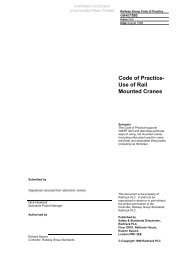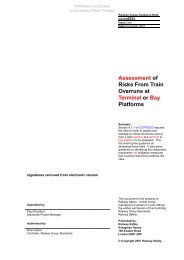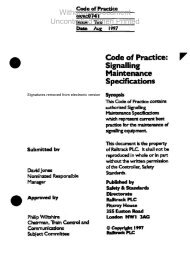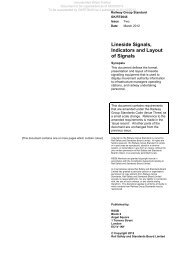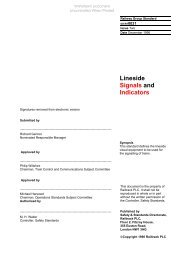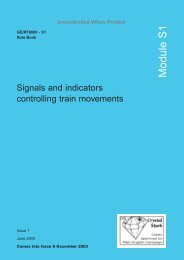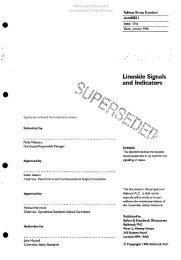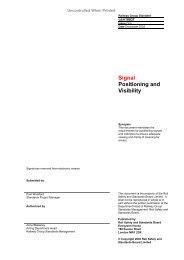General Information on Track Circuits - RGS Online
General Information on Track Circuits - RGS Online
General Information on Track Circuits - RGS Online
Create successful ePaper yourself
Turn your PDF publications into a flip-book with our unique Google optimized e-Paper software.
Railway Group Approved Code of Practice<br />
GK/RC0752<br />
Issue Two<br />
Date December 1998<br />
Page G2 of 3<br />
5 IRJ Inspecti<strong>on</strong><br />
6 Performance Test<br />
<str<strong>on</strong>g>General</str<strong>on</strong>g> <str<strong>on</strong>g>Informati<strong>on</strong></str<strong>on</strong>g> <strong>on</strong> <strong>Track</strong> <strong>Circuits</strong><br />
5.1 Testing of IRJs<br />
IRJs should be visually checked for indicati<strong>on</strong>s of insulati<strong>on</strong> deteriorati<strong>on</strong>, general<br />
c<strong>on</strong>diti<strong>on</strong> and rail burring over the insulati<strong>on</strong>.<br />
If an IRJ is suspect, a possessi<strong>on</strong> of the track circuits c<strong>on</strong>cerned should be<br />
obtained and the IRJ tested for insulati<strong>on</strong> break–down with the track circuits<br />
taken out of service. The metallic comp<strong>on</strong>ents of the IRJ being tested should be<br />
cleaned to allow a good electrical c<strong>on</strong>tact with the test leads. If the insulati<strong>on</strong><br />
resistance between either plate and rail is less than 2kΩ at 50V, thew joint is<br />
likely to fail or has partially failed and requires attenti<strong>on</strong>. The Engineering<br />
Supervisor should be notified so that arrangements can be made with the<br />
Permanent Way Engineer to replace the faulty IRJ.<br />
In the case of d.c. track circuits, IRJ’s may be tested with the track circuits in<br />
service under certain c<strong>on</strong>diti<strong>on</strong>s. This procedure is described in GK/RC0755<br />
Part F.<br />
5.2 Prefabricated IRJs<br />
Edil<strong>on</strong> and similar prefabricated IRJs must be tested with a 50V insulati<strong>on</strong> tester<br />
prior to installati<strong>on</strong> in the track, taking care that the IRJ assembly is not in<br />
c<strong>on</strong>tact with any c<strong>on</strong>ducting surface.<br />
Test:<br />
Withdrawn Document<br />
Unc<strong>on</strong>trolled When Printed<br />
a) Between the two rails.<br />
b) Between both fishplates and the two rails.<br />
c) Between each bolt and the two rails.<br />
The minimum acceptable reading is 500kΩ..<br />
a) The track circuit should be energised and adjusted in accordance with the<br />
relevant secti<strong>on</strong> in this handbook. If difficulties are experienced, refer to the<br />
Fault Finding Procedures.<br />
b) Ensure that the polarity/phase is correct and that the correct electrical<br />
stagger is achieved.<br />
c) <strong>Track</strong> circuit interrupters must be tested by disc<strong>on</strong>necti<strong>on</strong>.<br />
d) Ensure that all adjoining track circuits are energised. Remove the feed links<br />
of the track circuit under test to check that <strong>on</strong>ly the correct track relay or<br />
relays resp<strong>on</strong>d. Check that any remaining extraneous voltage <strong>on</strong> the track<br />
relay does not exceed that permitted for the particular track circuit design<br />
(see the Testing & Commissi<strong>on</strong>ing Part in the Code of Practice for the<br />
relevant track circuit).<br />
e) Set the shunt box to the minimum permitted drop shunt value, and apply<br />
sequentially at all extremities and at selected places within any S & C, to<br />
prove the functi<strong>on</strong>ality of the track circuit b<strong>on</strong>ding; the correct track relay<br />
must be seen to drop each time. For jointless track circuits, prove that the<br />
theoretical extremities are the actual extremities.<br />
G2 R A I L T R A C K



